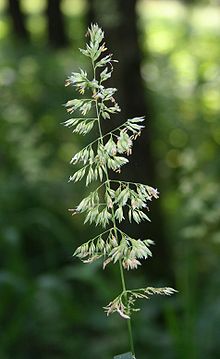- Reed canary grass
-
Phalaris arundinacea
Reed canarygrass
Scientific classification Kingdom: Plantae (unranked): Angiosperms (unranked): Monocots (unranked): Commelinids Order: Poales Family: Poaceae Genus: Phalaris Species: P. arundinacea Binomial name Phalaris arundinacea
L.Reed canarygrass, Phalaris arundinacea, is a tall, perennial bunchgrass that commonly forms extensive single-species stands along the margins of lakes and streams and in wet open areas, with a wide distribution in Europe, Asia, northern Africa and North America.
Contents
Description
The stems can reach 2.5 m in height. The leaf blades are blue-green when fresh and straw-colored when dry. The flowers are borne on the stem high above the leaves and are pinkish at full bloom.
Uses
A number of cultivars of P. arundinacea have been selected for use as ornamental plants, including variegated (striped) cultivars – sometimes called ribbon grass – such as 'Dwarfs Garters' and 'Strawberries and Cream'. The latter gets its name from the large white stripes and pinkish color that appears on the leaves at varying times. When grown, although drought-tolerant, it likes abundant water and can even be grown as an aquatic plant.
Reed canarygrass grows well on poor soils and contaminated industrial sites, and researchers at Teesside University's Contaminated Land & Water Centre have suggested it as the ideal candidate for phytoremediation in improving soil quality and biodiversity at brownfield sites.
The grass can also easily be turned into bricks or pellets for burning in biomass power stations.[1] Furthermore it provides fibers which find use in pulp and papermaking processes.
Reed canarygrass is also planted as a hay crop or for forage.
Invasiveness
In many places, reed canarygrass is an invasive species in wetlands, particularly in disturbed areas. When reed canary grass invades a wetland, it suppresses native vegetation and reduces diversity. The grass propagates by seed and rhizome, and once established, is difficult to eradicate.[2]
Chemical properties
Some Phalaris species contain gramine, which can cause brain damage, other organ damage, central nervous system damage and death in sheep.[3]
Leaves of P. arundinacea contain DMT, 5-MeO-DMT and related compounds.[4] Levels of beta-Carbolines have also been reported.[5]
References
- ^ Bond, Sam (2010-02-23). "Candidate crops for contaminated land biofuels crop considered". edie.net/crc. http://www.edie.net/news/news_story.asp?id=17706&channel=0. Retrieved 2010-04-17.
- ^ Ecology of freshwater and estuarine wetlands By Darold P. Batzer, Rebecca R. Sharitz
- ^ Toxicants of Plant Origin - Google Book Search. http://books.google.com/books?ie=UTF-8&id=eASgQyXq8xMC&pg=PA169&dq=%22mimosa+hostilis%22+dimethyltryptamine#PPA171,M1. Retrieved 2008-04-20.
- ^ Tryptamine Carriers FAQ
- ^ G. C. Marten, R. M. Jordan and A. W. Hovin; 1976; Biological Significance of Reed Canarygrass Alkaloids and Associated Palatability Variation to Grazing Sheep and Cattle; Agronomy Journal Vol. 68 No. 6, p. 909-914; doi:10.2134/agronj1976.00021962006800060017x
External links
Categories:- Poaceae
- Bunchgrasses of Africa
- Bunchgrasses of Europe
- Bunchgrasses of North America
- Flora of Asia
- Flora of Europe
- Flora of North America
- Grasses of the United States
- Grasses of Canada
- Garden plants of North America
- Garden plants of Europe
- Garden plants of Asia
- Herbal and fungal hallucinogens
- Psychedelic tryptamine carriers
- Invasive plant species
- Invasive plant species in Oregon
- Phytoremediation plants
Wikimedia Foundation. 2010.
